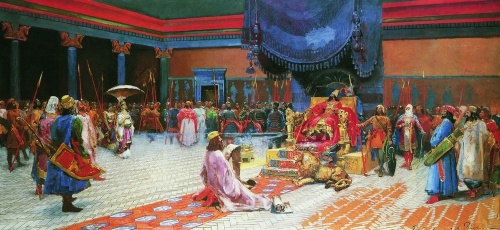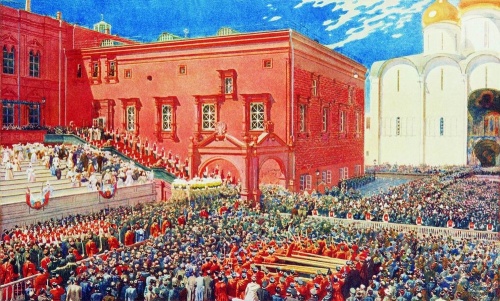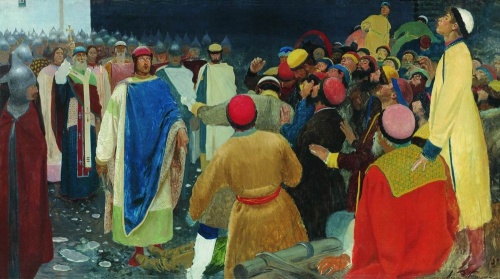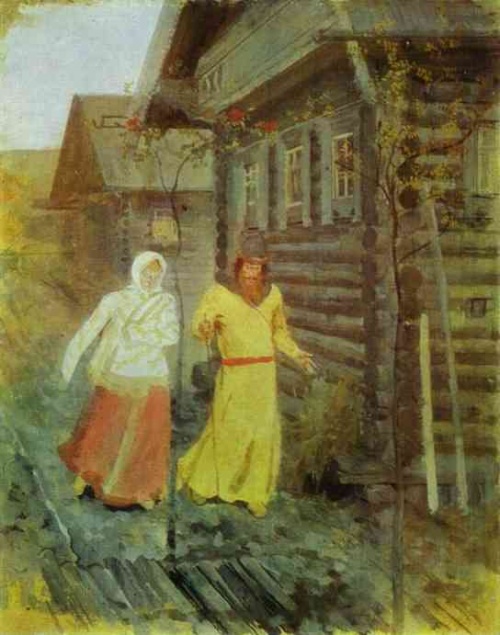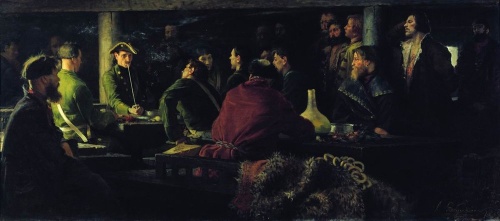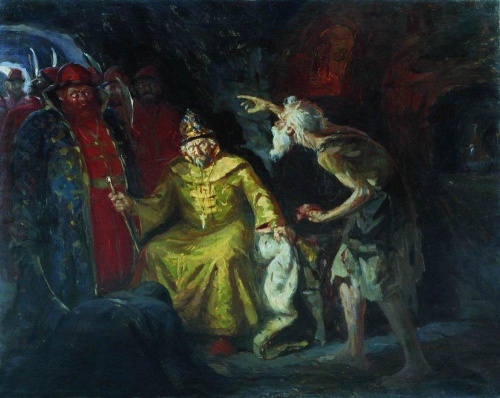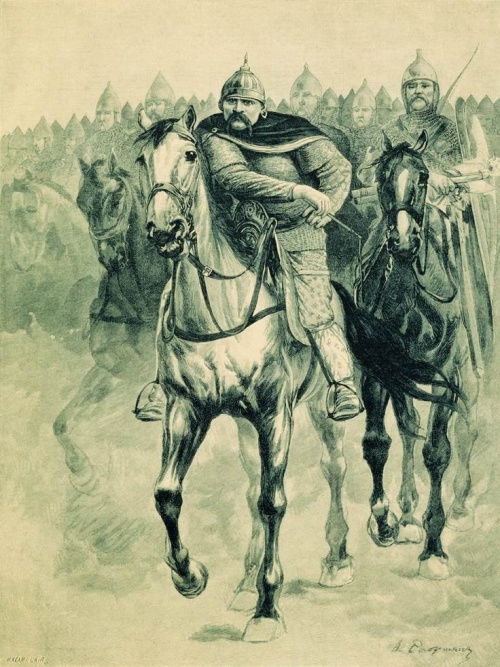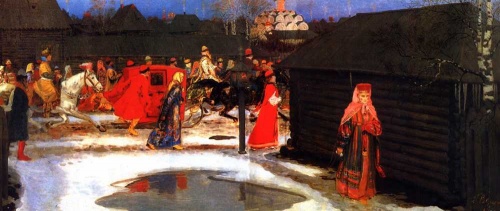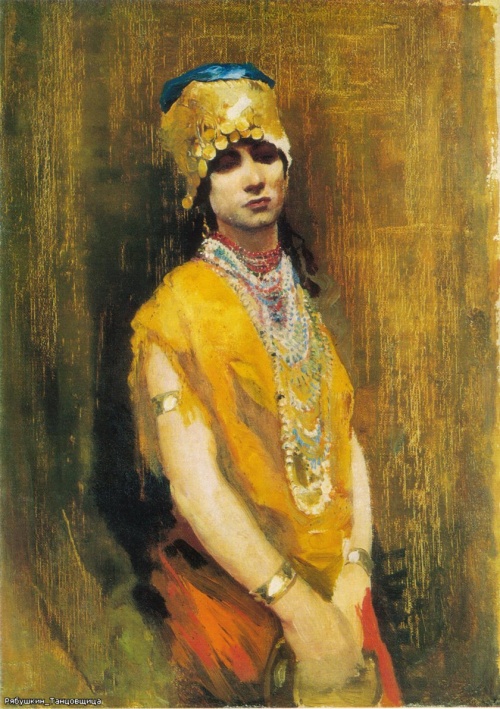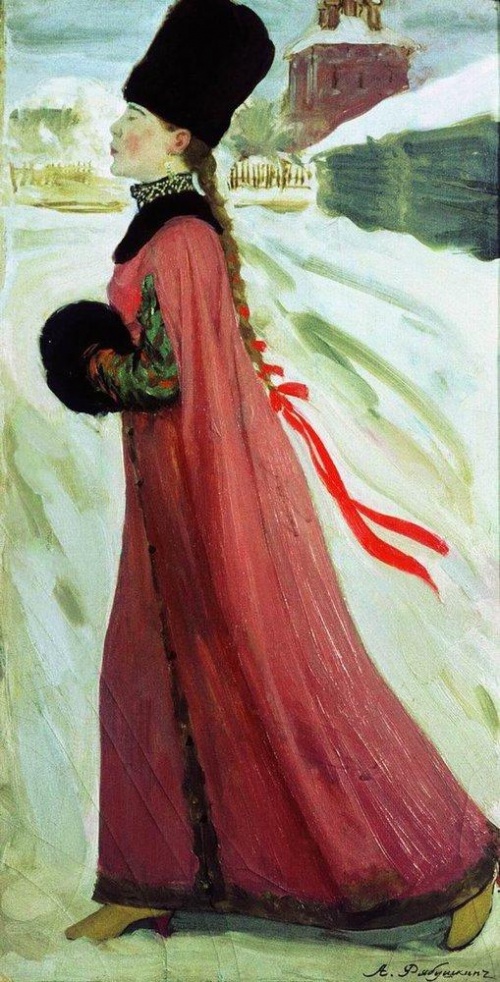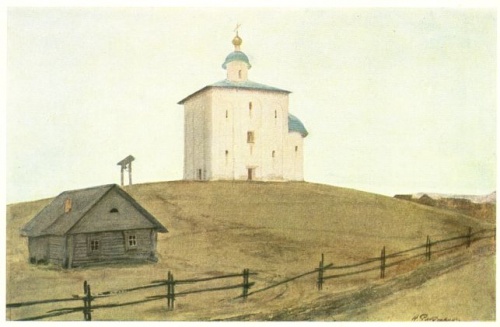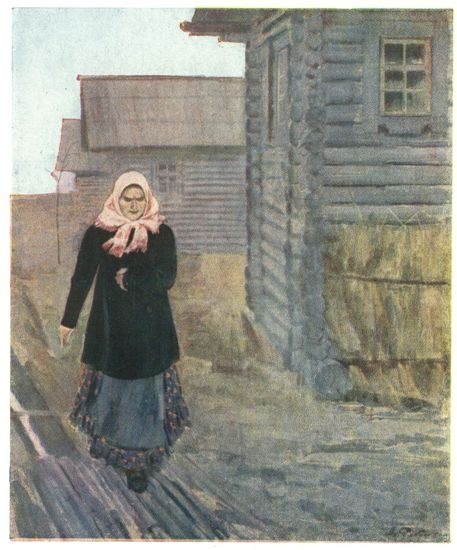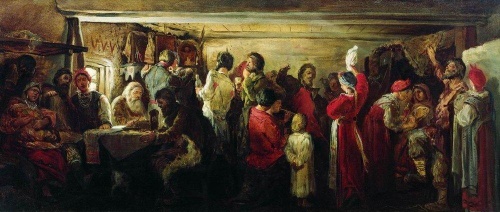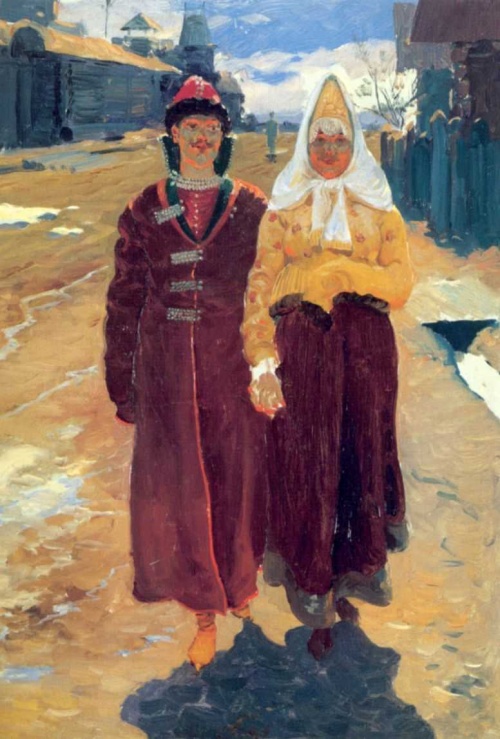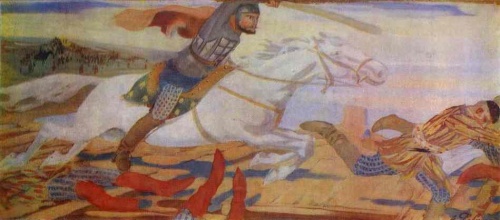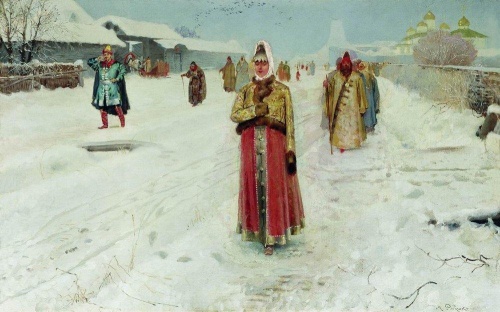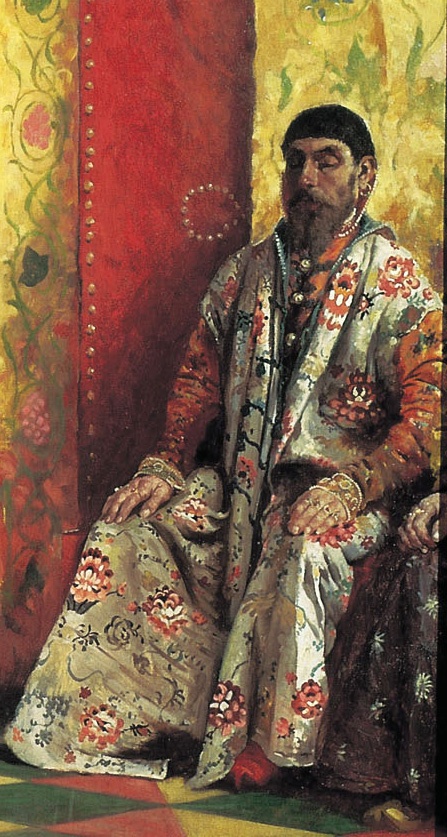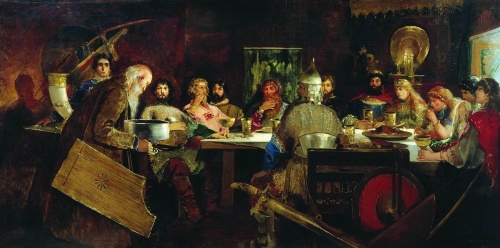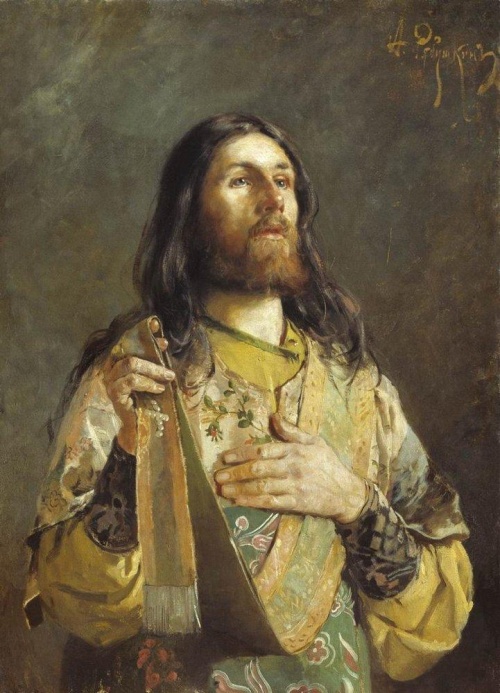Ryabushkin Andrey Petrovich (1861-1904) (54 works)
Разрешение картинок от 372x500px до 840x1192px
The artist was born in 1861, in the village of Stanichnaya Sloboda, Tambov province, in the Didvino estate.
Fragile and sickly, “as if carrying some kind of secret within himself,” “a man of great talent and great, hidden passions” (M. V. Nesterov), A. P. Ryabushkin created paintings in which, in a poetic form and with his characteristic He presented the life of Ancient Rus' with a natural sense of decorativeness.
Ryabushkin was born into the family of a peasant icon painter. At the age of fourteen, the boy was orphaned and left with his older brother, who inherited his father’s profession. Chance helped Ryabushkin become an artist: his abilities were noticed by A. Kh. Preobrazhensky, a student at the Moscow School of Painting, Sculpture and Architecture, who was visiting the village. He took the boy to Moscow, enrolled him in the School and took the most ardent part in his fate. After the death of his teacher, V. G. Perov, Ryabushkin continued his studies at the St. Petersburg Academy of Arts (1882-90). His works were invariably recognized with awards, but for his diploma painting “The Descent from the Cross” (1890) Ryabushkin did not receive a large gold medal for the reason that he deviated from the sketch initially approved by the Council of the Academy of Arts. The upset artist already intended to cut the huge (129 cm) canvas into pieces and use it for other works, but then P. M. Tretyakov visited his workshop and bought the painting.
The President of the Academy of Arts, Grand Duke Vladimir Alexandrovich, considered it necessary to provide Ryabushkin from his personal funds with the amount that gold medalists are entitled to for a trip abroad, although for a period of not three, but two years. And Ryabushkin set off through the old cities of Russia. He visited Novgorod, toured Moscow and the Moscow region again, then looked at Kyiv, Tula, Orel, Ryazan, Uglich, Yaroslavl, Rostov, Kostroma, Nizhny Novgorod. Everywhere he writes sketches of churches, copies fragments of ancient frescoes, and sketches ornaments. He studies ancient fabrics, household items, costumes, and weapons in museums. He enthusiastically reads literature on the history of Rus', chronicles, and folk tales. All this has interested him for a long time: since the 1880s. forced to work part-time all the time, student Ryabushkin constantly publishes in various illustrated magazines compositions on topics from the history of Ancient Rus', as well as everyday sketches from the life of a modern Russian village (he will continue to work in magazine and book graphics). It must be admitted that a serious study of historical realities did not entail stylization. Ryabushkin's story leaves the impression of living life. With this rare gift he resembles V.I. Surikov. The artist settles near St. Petersburg, not far from the Lyuban station, on the Privolye estate of his friend I. F. Tyumenev. Here, in a house with a workshop specially built for him, he begins his independent journey with two versions of the genre painting “Waiting the newlyweds from the crown in the Novgorod province” (1891) and the historical composition “Amusing in the circle” (1892; depicting soldiers of the amusing regiments of Peter 1 and archers in tavern). The painting of these canvases is still dark in the style of the Peredvizhniki. But something new appears - the absence of detailed action. Dramatic clashes are not to Ryabushkin’s heart. This will continue to be the case in the future. These works were accepted for exhibitions of the Itinerants.
But the next picture in which the artist finally found himself - the bright, colorful "Sitting of Tsar Mikhail Fedorovich with the boyars in his sovereign room" (1893) - the Wanderers refused to take. Why? Too unusual. Again there is no action, or rather, all action consists of inaction - in “thinking” about state affairs, depicted very ironically. Furnishings turn out to be more important here than people who are almost falling asleep from boredom. Ryabushkin delights in depicting the cheerful patterns of painted walls and ceilings, rich brocade clothes, a tiled stove, a twisted chandelier, and a throne decorated with inserts of precious stones.
In the 90s, the artist performed many commissioned works, drawings and watercolors for various publications and albums, and sketches of compositions for the proposed painting of the St. Sophia Cathedral in Novgorod.
In 1895, the artist shows a large canvas “Moscow Street of the 17th Century on a Holiday.” Among the ancient architecture, dressed in ancient costumes, men and women, copied by Ryabushkin from the peasants of the village where he lived, wander knee-deep in the impassable mud. Their faces bear the imprint of eternal everyday problems. An ordinary cold autumn day.
The usual peredvizhniki contrast between the poverty of some and the soulless selfishness of others. Ryabushkin is either more inclined to the genre, as in this picture, or to the external beauty of the old way of life - “Russian women of the 17th century in the church” (1899). There is an unusually beautiful color combination of bright patterned fabrics - blue, yellow, different shades of red; the gold of hair, crowns, and brocade headdresses is juxtaposed with the ocher-green-blue painting of the church walls, with patterns of colored glass in the windows. These two paintings and “The Family of a Merchant in the 17th Century” (1896) received an honorable mention at the World Exhibition in Paris in 1900. Ryabushkin gained great fame.
He is appreciated by I. E. Repin, V. D. Polenov, and "
World of Art", at the exhibitions of which he has been showing his works for some time. However, he did not take root with them and subsequently joined the association "36 Artists". The most famous of Ryabushkin's later works is "Wedding Train in Moscow (XVII century)" ( 1901). Like a fairy-tale vision, a red wedding cart rushes down the street, accompanied by walkers and horsemen. Around are smart passers-by, accustomed to such a spectacle. The landscape is almost Savrasov: early spring, a small white church in the distance, all in kokoshniks, illuminated by the setting sun, dark wooden buildings around, a puddle in the foreground, touched by thin ice.
Ryabushkin also depicted the modern village, but without the former poeticization - he clearly saw how the old way of life was being destroyed (“A guy got into a round dance, well, the old woman groaned...”, 1902).
In the gouaches "Tea Party" (1903), members of one family are forever separated from each other by rivalry, envy, monetary interests, and selfishness. There is no former poeticization of Russian village life here. In terms of the strength and sharpness of its psychological characteristics, this work can only be placed next to S. Korovin’s painting “On the World.”
Among the artist’s latest works there is one that can be called symbolic. This is a tiny landscape "Novgorod Church". On a bare hill, open to all winds, an ancient temple stands like a lone warrior. Dilapidated huts, as if grown into the ground, do not even rise above the horizon.
From the memoirs of M. Nesterov:
“The paintings became more and more independent, approaching the full expression of his artistic appearance. And yet Andrei Petrovich developed slowly, something hindered him - whether it was his heavy heredity, or the personal properties of his character, it is difficult to say.
He began to “break down” more often. Such attacks, which ended badly, became more pronounced. This is what I saw one day, while passing through Nizhny to Ufa: on the way from the station to the pier, a reckless driver was rushing towards my cab driver. From the reckless driving of the reckless driver, the droshky somehow bounced, rolled over the round cobblestones of the pavement - they approached us with lightning speed. Behind the reckless driver I saw the riders - two dressed up girls, one in orange, the other in bright green. The feathers of their huge hats fluttered in the wind. One of the girls was sitting next to him, the other on the knees, in a risky pose, of a small, pale man with a white beard. This man was Andrei Petrovich Ryabushkin. He recognized me, shouted: “Hello, Mikhail Vasilyevich”... The droshky rushed by and quickly disappeared around the corner. They also said this. While finishing or having already graduated from the Academy, Andrei Petrovich began to earn a lot of money from illustrations. Having accumulated several hundred, he disappeared for a week. Nobody knew where to look for him. And it was only by chance that they found out where Andrei Petrovich disappeared on such days. He then retired to the hot places... There, according to a special agreement with the “madame,” he paid her her weekly profit by check and remained the complete owner of the establishment, which was closed on such days. The new sultan changed the life of the establishment. Everything had to be agreed upon with his capricious tastes... And he, so strange, now extinct, now riotous and wild, demanded new and new impressions.
Once, during the days of such revelry, a miraculous icon was brought to the establishment by special order. They greeted the icon with due honor. A prayer service was served in the hall, after which the icon, at the special requests of the girls, was carried through all the rooms of the establishment, everything was sprinkled with holy water. The more sensitive girls cried with emotion. Andrei Petrovich took a lively part in the home celebration, vigilantly peered into everything that was happening, prayed earnestly with everyone, and when the ceremony was over, he generously paid the priest. And the girls carried the icon in their arms to a carriage drawn by a train.
That day passed in a particularly concentrated mood. And for a long time Andrei Petrovich allegedly cherished the idea of painting the painting “Bringing the Miraculous Icon.” The picture was not painted. I think that if Ryabushkin had carried out his idea, it would have been one of the best genre paintings in the spirit of his “Tea Party”...
In the last years of his life, Ryabushkin became interested in creating illustrations for Russian epics.
Andrei Petrovich was a sensitive musician; he had a small, pleasant voice. Andrei Petrovich was no stranger to composing, subtly understanding the spirit of folk songs.
In recent years, Ryabushkin was seriously ill (pulmonary tuberculosis). Doctors advised him to go to Switzerland, where he went in 1903. But the trip turned out to be fruitless. Returning to his homeland, Didvino, the artist, surrounded by friends, died in his studio on May 10, 1904. Russian art has lost a great, original, truly national artist. He managed to do a lot, but there is a feeling that he did not say everything he could...
